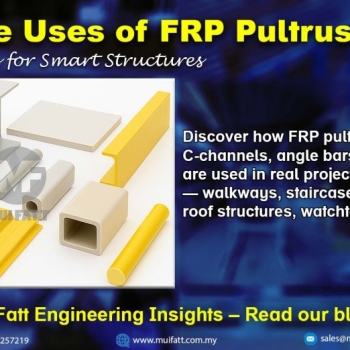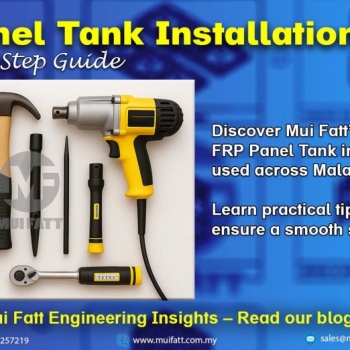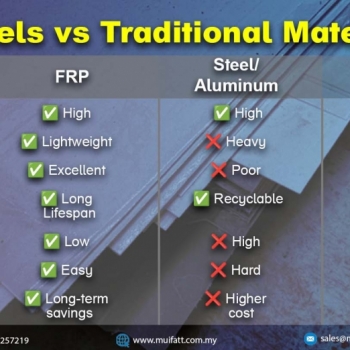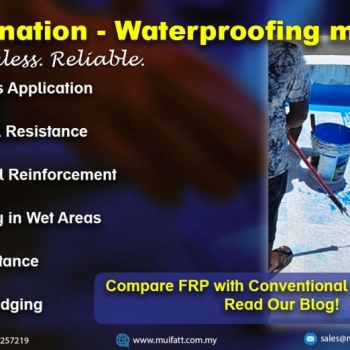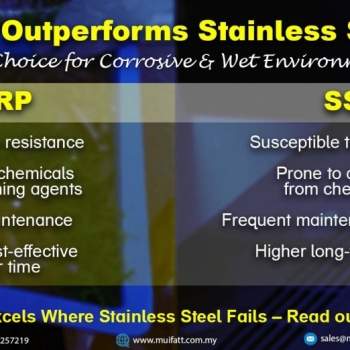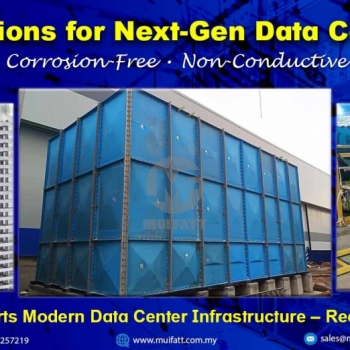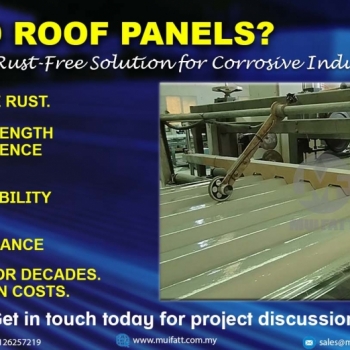FRP pultruded profiles are reshaping structural possibilities across Malaysia. From STP staircases to public park shelters, explore how these modular components enable custom FRP solutions—only from Mui Fatt.
Benefits of FRP in Food Handling & Processing
27 May 2025
- Key Takeaways
- What is FRP and Why It’s Used in the Food Industry
- Benefits of FRP in Food Handling Applications
- Common FRP Equipment in Food Processing
- Real-World FRP Use Cases in the Food Industry
- How FRP Compares to PE or Stainless Steel
- Why More Industries are Turning to FRP
- Mui Fatt’s Success Stories in Food Industry Applications
- Frequently Asked Questions (FAQ)
Key Takeaways
-
FRP is corrosion-resistant, non-toxic, lightweight, and easy to clean—ideal for food handling.
-
It is suitable for both wet and dry food processing environments.
-
Mui Fatt offers customizable FRP food trays, tanks, grating, and lamination services.
-
FRP outperforms traditional materials in durability and hygiene.
-
Successfully used in supermarkets, food factories, and agricultural processing.
In the modern food industry, materials used for handling and processing play a crucial role in maintaining hygiene, durability, and compliance with food safety standards. One material that has been gaining increasing attention is Fibreglass Reinforced Plastic (FRP). From supermarket display trays filled with ice to industrial platforms in food factories, FRP proves to be a high-performance, food-safe solution.
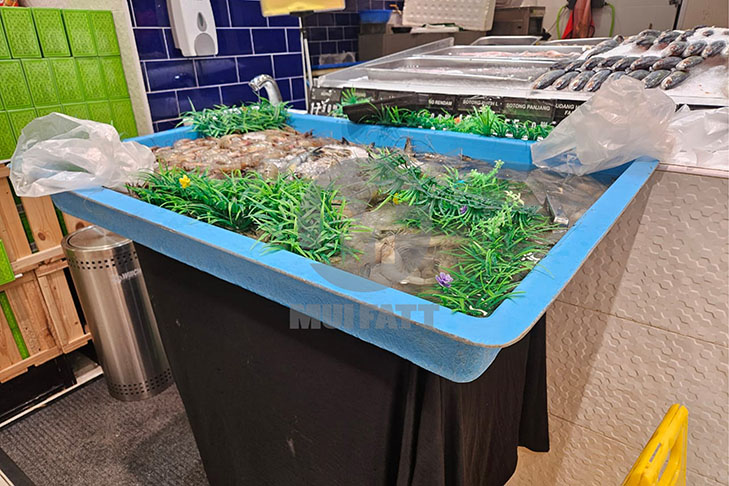
What is FRP and Why It’s Used in the Food Industry
FRP is a composite material made from a polymer matrix reinforced with fiberglass. It resists moisture, bacteria, chemicals, and physical damage, making it ideal for food-grade applications.
Benefits of FRP in Food Handling Applications
Hygienic and Non-Toxic
FRP is easy to clean, non-porous, and does not support bacterial growth.
Corrosion & Chemical Resistance
Perfect for environments involving moisture, brine, or food-grade cleaning agents.
Lightweight and Strong
Easier to transport and install compared to stainless steel without compromising strength.
Long Service Life & Low Maintenance
Reduced replacement frequency and lower lifecycle costs.
Common FRP Equipment in Food Processing
-
FRP Supermarket Fish Trays – withstand ice, moisture, and constant cleaning.
-
FRP Water Storage Tanks – ideal for food processing and cleaning systems.
-
FRP Grating Platforms – used in food manufacturing and washdown areas.
-
FRP Lamination – protective lining on agricultural tools or mixers exposed to food-related chemicals.
-
FRP Cabinets & Benches – ideal for chemical-resistant food lab or prep areas.

Real-World FRP Use Cases in the Food Industry
-
Hypermarket Seafood Display: Fresh fish & seafood display with ice (Supplying FRP Fish Trays to a Local Hypermarket Chain)
-
Food Factory Walkways: Grating used for anti-slip platforms and drain covers
-
Agriculture Sector: FRP laminated tanks and tools used in fertigation and wash stations
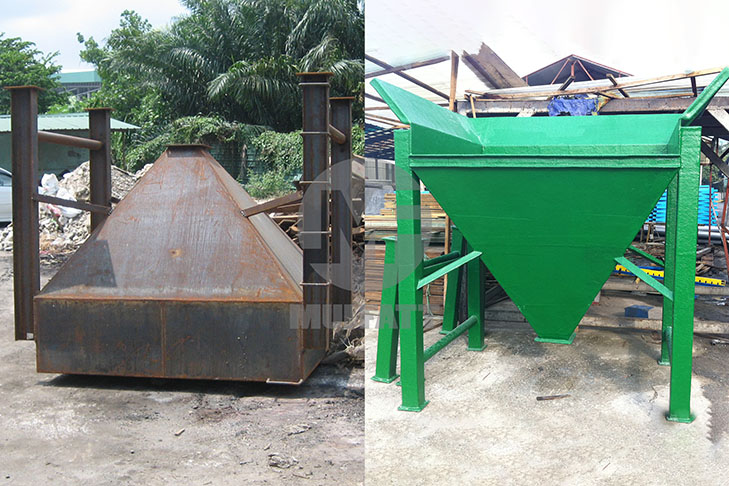
How FRP Compares to PE or Stainless Steel
| Material | FRP | Stainless Steel | PE |
|---|---|---|---|
| Corrosion-Resistant | ✅ Excellent in harsh/wet zones | ✅ Good, but may rust over time | ✅ Good, but limited durability |
| Weight | ✅ Lightweight | ❌ Heavy | ✅ Lightweight |
| Hygiene | ✅ Non-porous & easy to clean | ✅ Easy to sanitize | ❌ May degrade in heat |
| Cost-Effective | ✅ Long-term savings | ❌ High initial cost | ✅ Affordable |
Why More Industries Are Turning to FRP
From food and beverage to agriculture and aquaculture, more industries recognize the advantages of FRP for demanding, wet, or sanitary environments. FRP’s adaptability and compliance with safety standards make it a smart long-term investment.
Mui Fatt’s Success Stories in Food Industry Applications
Mui Fatt has supplied:
-
Over 1000 FRP fish trays to a major hypermarket chain
-
Customized FRP grating platforms for food factories
-
FRP tanks and laminated parts for agriculture-related food processing
As the demand for safe, hygienic, and long-lasting food handling materials grows, FRP is proving to be a game-changing solution. At Mui Fatt, we offer customizable FRP solutions built for performance and compliance.
Need a custom FRP solution for your food processing needs? Talk to our team today via WhatsApp or email at sales@muifatt.com.my to explore our FRP Product Range.
Frequently Asked Questions (FAQs)
Is FRP safe for food contact?
Yes. FRP used in food handling is non-toxic and complies with hygiene standards.
Can FRP be used in cold storage or icy environments?
Absolutely. FRP performs well in cold and wet conditions—making it ideal for fish trays and storage applications.
What’s the maintenance required for FRP food equipment?
Very minimal. Regular cleaning with food-grade detergents is sufficient due to its non-porous nature.
Does Mui Fatt offer customized FRP food equipment?
Yes. We offer custom fabrication for trays, tanks, platforms, and more based on your industry requirements.
#FRPforfoodhandling #FRPfoodtrays #FRPinfoodindustry #FRPfoodprocessingequipment #FRPfishtrayMalaysia
Disclaimer:-
The content on this site is for general information and entertainment purposes and does not constitute legal counsel. We strive to keep our information as accurate as possible. However, we make no warranties about the completeness, accuracy, reliability, suitability, or availability with respect to the information contained on this page. You should rely on this information at your own risk. This website may include links to other third-party sites. These links are provided as a convenience to you as a reader, user, or browser only. We make no representation, warranty, or guarantee, nor do we endorse or take responsibility for any of the content of such sites.
Stay in touch with us if you’re interested in hearing from us promptly.
- Website - https://www.muifatt.com.my/home/
- Facebook - https://www.facebook.com/muifattmarketing
- Instagram - https://www.instagram.com/muifattmarketing/
- Google - https://goo.gl/maps/WxVY13gNcaRTS7Jp6
- Youtube - http://www.youtube.com/@MuiFattMarketing
- TikTok - https://www.tiktok.com/@muifattmarketing
- LinkedIn - https://www.linkedin.com/company/mui-fatt-marketing-sdn-bhd-
- Linktree - https://linktr.ee/muifattmarketing
- Shopee - https://www.shopee.com.my/muifattmarketing
- Lazada - https://www.lazada.com.my/shop/mui-fatt-marketing
Recent Blog
Mui Fatt Engineering Insights - FRP Panel Tank Installation
Get to know the step-by-step assembly process of FRP sectional panel tanks, based on Mui Fatt’s industry-proven practices. This easy-to-digest guide is ideal for project managers, contractors, and technical personnel involved in water storage tank installation across Malaysia.
FRP Panels vs Traditional Alternatives: The Ultimate Guide to Durability and Sustainability
Explore why FRP (Fiberglass-Reinforced Plastic) panels outperform traditional materials like steel, plywood, and PVC in durability, sustainability, and cost-effectiveness. Discover real-world applications in MyKiosk projects and cold truck panel assembly, where FRP’s superior insulation, corrosion resistance, and lightweight properties deliver long-term benefits.
Comparing FRP Waterproofing with Traditional Systems
Is FRP lamination a better waterproofing method than traditional systems? Explore this complete guide with real project examples and see why FRP is gaining traction across Malaysia.
Mui Fatt Insights: Advanced Materials for Modern Needs
Is stainless steel the best for wet areas? This article explains why more industries are switching to FRP for its corrosion resistance, hygiene benefits, and longevity, especially in food displays and chemical exposure zones.
How FRP Supports Modern Data Center Infrastructure
Discover how fiberglass-reinforced plastic (FRP) is reshaping data center construction. Learn its key advantages, comparisons with other materials, and where to apply FRP—from rooftop chillers to cooling tanks.
Understanding FRP Filament Winding: Process, Benefits & Comparison
This article explores the FRP filament winding manufacturing method, how it differs from other FRP techniques, why it’s still widely used, and its long-term value for projects like high-strength tanks and cylinders.
Rust Problems? Discover Why FRP Roofing Is the Superior Choice
Tired of dealing with rusted roof panels? Learn how FRP roofing offers a corrosion-free, custom-fit solution — and why it outperforms metal for industrial environments.
